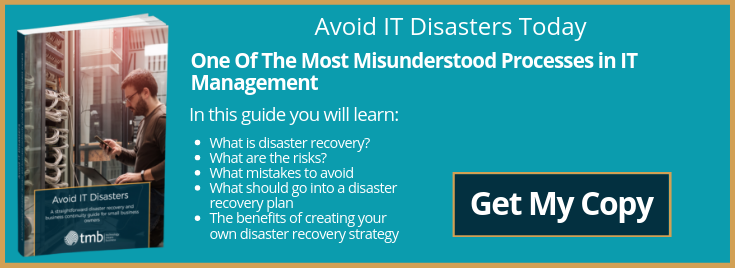What Is Disaster Recovery & When Does It Matter?
Disasters happen all of the time. From fires to floods to cyber-attacks, nature – both human and environmental – can throw many hazards in the path of hard-working businesses. Increasingly, technology is the backbone of organisations. When something goes wrong with IT, companies can find it impossible to recover.
Let’s take a look at disaster recovery, and when you are likely to need it.
Disaster Recovery: What Is It?
If you look around your workplace, you can probably see a lot of health and safety signage. You’re likely to have a fire evacuation strategy and a designated first aider, as well as sprinklers to keep your assets safe. If something does happen, there are trained professionals ready to take over and help.
This preparedness represents knowing how to respond in the event of a problem. It is about limiting the risk of known hazards and being prepared to act swiftly in the event of an incident.
Disaster recovery is the digital equivalent. It is about making sure that the right preparations are made – such as reliable data backups – and that everybody knows how to respond if an emergency happens. It means enabling business continuity, no matter what hazards appear, by having the right professional support and safeguarding.
Why Does Disaster Recovery Matter?
Disaster recovery has an important economic incentive. Each day of downtime can cost upwards of £8,000 for an SME and up to £700,000 for a large business. When digital disasters occur, the average cost in time is equivalent to 50 days of business. GDPR non-compliance fines can also be hefty.
What Causes Digital Disasters?
There are several main causes. These include damage to hardware, corrupted files, data theft and malware attacks. Damage to hardware and files can be caused by relocations, software upgrades, compatibility problems and workplace accidents. Cyber-attacks are increasingly frequent. Statistics suggest that a successful malware breach happens every 14 seconds, with the latest Accenture study of cyber-attacks on US businesses finding an average cost of $2.4 million per attack. 43% of all cyber-disaster costs relate to information loss, and surveys suggest that 69% of organisations don’t think that their security software can keep up with the threats.
Statistically, your organisation will be affected at some point. Disaster-preparedness is about being ready for that day.
When Am I Likely To Be Affected?
The most routine threat is cybercrime. Cyber-attacks are a constant barrage and often happen automatically. Particularly high-risk times are when a new threat is launched at your industry, or when your old legacy software stops being updated. Banking and finance, governments and healthcare providers, and SMEs are particularly vulnerable – partly because of their reliance on old in-house software, and partly because they make attractive targets. Living in London or Berlin increases your risk dramatically due to exposed connections.
What Next?
Working with a professional team can ensure that your company has the maximum protection and emergency response strategy, so if the worst should happen, your business can keep going. For more information, download our free Disaster Recovery Guide today.


